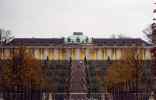Sanssouci Palace
The palace and park of Sanssouci belong to the UNESCO World Cultural Heritage and are considered to be a pearl of Northern German Rococo. The palace was built as a summer residence for Friedrich II from 1745 to 1748 under the management of Baron von Knobelsdorff. The palace stands like a villa on a hill which is called the “wüste Berg” (desolate mountain). The single-storey building, which is approximately 152 m long, does not stand on a base, nor has it a cellar, and therefore appears to be very flat and closely linked with the garden. This is just how the owner King Friedrich II imagined his residence to be.
This was his favourite palace, and it was here where the king lived from April to October. At the same time he had the Potsdam City Palace extended and used it as his winter residence. The building of Sanssouci goes back mainly to Friedrich the Great’s own plans. He was seeking a refuge where he could devote his time to the arts and philosophy. Friedrich had also thought of his last resting-place. He had a crypt built. There he is said to have spoken the memorable words: “Quand je serais là, je serais sans souci” - hence the name of the palace.
Sanssouci didn’t only consist of the two-winged main building with the light cupola in the central section. Directly behind the building Friedrich had a colonade with 48 pairs of linked Corinthian columns built which stand in two rows in a semi-circle.
One must also mention the sculptures on the side of the garden. 36 larger-than-life-size figures - two between each window - support the cornice of the palace. The facade layout of Sanssouci reflects the transition from Rococo to Classicism quite clearly. While the front facade of the palace looking onto the garden is held in completely fanciful Rococo forms, the rear side appears in a severe classical form with its colonades.
King Friedrich II gathered great European scholars about him, among them were Goethe, Voltaire and Bach. He cultivated music as well as extremely learned discussions. The king avoided the company of ladies. His own wife lived far away and only saw her husband very rarely. In spite of long-lasting friendships, the king died an old, lonely man. He was repeatedly disappointed by many of his closest friends so that he became more and more bitter. He died in 1786 leaving no children, and left the throne and his Sanssouci to his nephew Friedrich Wilhelm II who chose Sanssouci as one of his residences, as did his successors. Friedrich the Great’s wish to be buried next to his dogs in the crypt of Sanssouci was only fulfilled 205 years after his death. On 17 August 1991 the mortal remains of the king were taken from the family castle of the Hohenzollern near Hechingen to Sanssouci and buried there.










